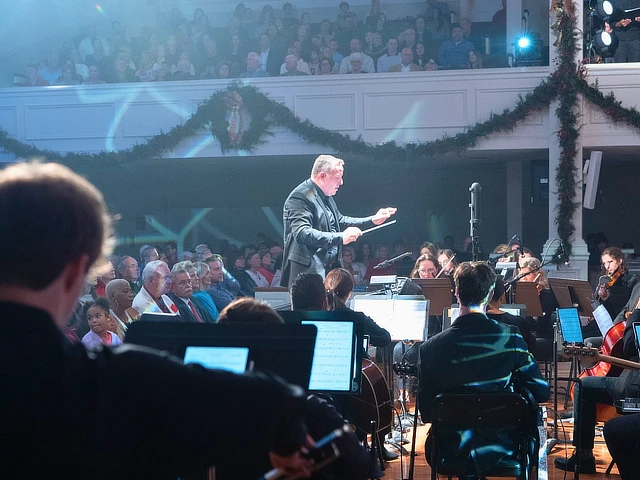
Imagine for a moment you’re sitting in a symphony hall ready to hear your favorite music by your favorite symphonic orchestra. Maybe you’re anticipating the warm layers of the strings, the playful woodwind melodies, the powerful brass, or the driving rhythms of the percussion. You can begin to literally feel the depth and richness of sound mixing to engage your heart, mind, and soul. You may even feel transported somewhere else. There’s not much like hearing an orchestra come to life with music.
Similarly, imagine yourself in your church sanctuary as you prepare for worship of Almighty God. The orchestra begins the service with all its rich, diverse sounds, immediately engaging your entire being. You may even find yourself more emboldened to stand in response to your Creator and engage wholeheartedly in singing praises to the King!
The main purpose of the Church Orchestra is to provide an underscore for the expressed praise of a congregation. Its presence supports the congregants, allows for personal service for the musicians, and edifies the church in corporate worship. Furthermore, there is both Biblical and Historical precedent for the use of instruments in worship.
Every one of these reasons is powerful enough to encourage us to welcome the presence of Church Orchestras within local congregations!
Let’s look at the important role instruments have had from Biblical times to today. From Genesis to Revelation, we see instances where musicians are using their instruments to actively declare God’s glory and presence among His creation. A variety of instruments have been used in worship, including the harp, lute, shofar, and even the bells attached to the priest’s robe. These harmonious and rhythmic tones play a vital role in connecting stories to emotions, conveying God’s narrative across generations.
The Church Orchestra has evolved over the years, reflecting changes in musical style and instrumentation. Historically, churches used orchestras alongside mass choirs and organs, aligning with the cultural music norms of the time. As musical styles inevitably shift, many churches struggle to adapt, sometimes leading to the dissolution of their orchestras or entire music ministries. This highlights a need for flexibility and understanding of the Church Orchestra’s role in modern worship practices.
Currently, the instrumentation of the Church Orchestra has shifted to resemble a symphonic orchestra with a rhythm section, a change influenced by the Contemporary Christian Music industry. This evolution has brought significant changes in Sunday worship expressions, but it does not mean that the Church Orchestra must fade away. It is crucial to remember the construct and function of the local church orchestra to ensure it continues to have a voice in today’s worship expression.
The great news is that many resources for full orchestras are readily available for churches, allowing them to express their worship in a wide range of styles that are both familiar and fresh to the congregants. The Church Orchestra enlivens gathered worship through its sound, movement, and presence, creating a musical foundation that gives more sonic room for the individual to participate vocally. I have heard many church members say that the orchestra gives them the confidence to sing louder. The physical movement of playing the instruments often encourages the congregation to be more physically engaged as well, whether that means lifting their hands, clapping, or swaying.
The physical image of an orchestra in front of the congregation visually displays the Biblical truth found in 1 Corinthians 12:20, which states, “As it is, there are many parts, yet one body.” A Church Orchestra features a variety of instruments, each contributing to the whole song. Whether playing melody, harmony, or rhythm, the various instruments help congregants understand that everyone has a voice to offer in worship and a part in the Body of Christ. Similarly, musicians participating in the Church Orchestra find their unique roles within the Body of Christ.
Regardless of their level of training, musicians in the Church Orchestra can offer their talents and gifts to God in worship while continuing to learn and grow musically and spiritually. They find community among other musicians, building friendships and growing in faith as they learn to follow Christ. The Church Orchestra uniquely allows for intergenerational and multicultural engagement within the church, as music is a language that transcends socio-economic, political, and geographical boundaries.
A Church Orchestra creates space for teenagers to sit next to older adults, providing a common purpose and mentoring opportunities from one generation to the next. It invites cultures that may struggle to understand each other to share the common language of music, resulting in opportunities to share the Gospel message together. The Church Orchestra, whether as smaller ensembles, fully symphonic, or a rhythm section with fewer instruments, is an essential part of worship expression.
Regardless of its instrumentation, time, culture, or musical era, the purpose of the Church Orchestra has remained the same: allowing musicians the opportunity to express worship together and help others “recount the righteous victories of God.” This is a needed addition to any congregation.
Dan Mullis serves as the Associate Music & Worship Minister for the Dawson Family of Faith leading a variety of instrumental and choral ensembles. His passion in ministry is to encourage and equip musicians to connect to God’s story and mission wherever they are given the opportunity. He holds a Master of Worship Studies from the Robert E. Webber Institute for Worship Studies and a Bachelor of Music in Church Music from Belmont University. In addition to his role at Dawson, Dan enjoys assisting local schools in teaching student musicians in trombone and jazz studies. Dan’s previous ministry roles encompass serving as the Instrumental Music Minister and Conductor for the Jacksonville Praise Orchestra. He has also engaged in and led music missions across multiple countries. As a musician, Dan has performed alongside notable groups and artists, including Denver & the Mile High Orchestra, Travis Cottrell, Christafari, and Truth. He is joined in ministry by his wife, Carrie and their two sons, Caleb and Ethan.
